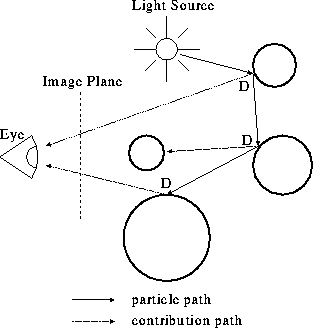Dutre proposed an algorithm that does not require mesh generation and can handle all types of light-surface interactions [DLW93]. This algorithm is based on particle model and direct computation of pixel intensities. Particles perform random walk through the scene and whenever a surface is hit, a ray is traced from the intersection point to the eye and direct light source contribution is added to the relevant pixel.
The random walks are denoted by a sequence of pairs
![]() ,
where
,
where ![]() and
and ![]() is the last point generated. For the ith particle
the pair
is the last point generated. For the ith particle
the pair ![]() is the pair
is the pair ![]() representing the starting point and starting direction
of the ith particle.
representing the starting point and starting direction
of the ith particle.
for each particle (): determine the starting position
trace a ray towards the eye and add the direct light source contribution to the relevant pixel determine the new direction
absorbed = False;
repeat until absorbed: compute
trace a ray from
to the eye and add the reflection contribution to the relevant pixel use the subcritical PDF to generate
or to absorb the particle j=j+1 determine
for each pixel display image

The new direction ![]() is chosen according to the subcritical
pdf (spdf) on the basis of importance sampling:
is chosen according to the subcritical
pdf (spdf) on the basis of importance sampling:
![]()
where ![]() is the bi-directional reflection
distribution function (BRDF). The pdf is subcritical because it does not
integrate to 1 over all possible angles, at least for physically valid
BRDFs. The actual value of the integration gives the chance that random
walk is continued, which ensures that the random walk terminates.
This technique is commonly called Russian roulette.
is the bi-directional reflection
distribution function (BRDF). The pdf is subcritical because it does not
integrate to 1 over all possible angles, at least for physically valid
BRDFs. The actual value of the integration gives the chance that random
walk is continued, which ensures that the random walk terminates.
This technique is commonly called Russian roulette.